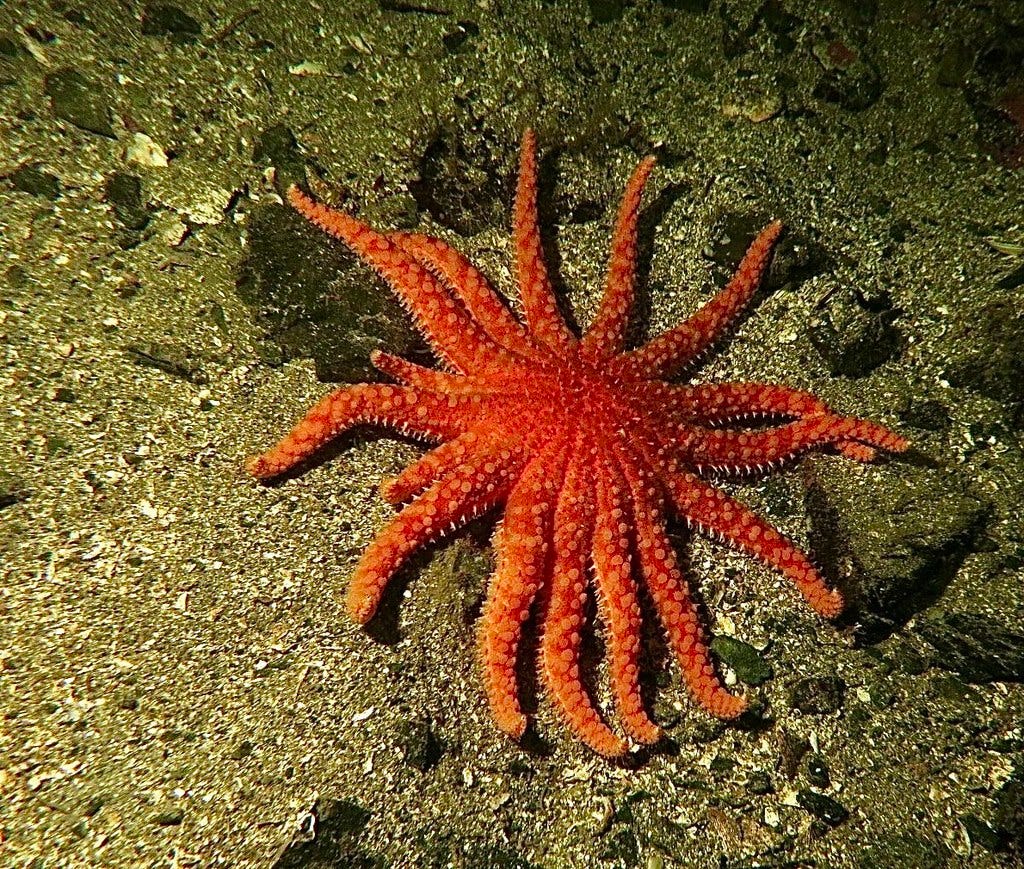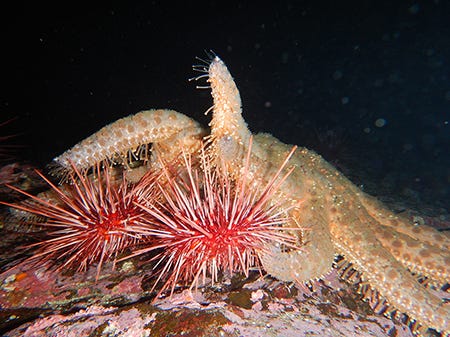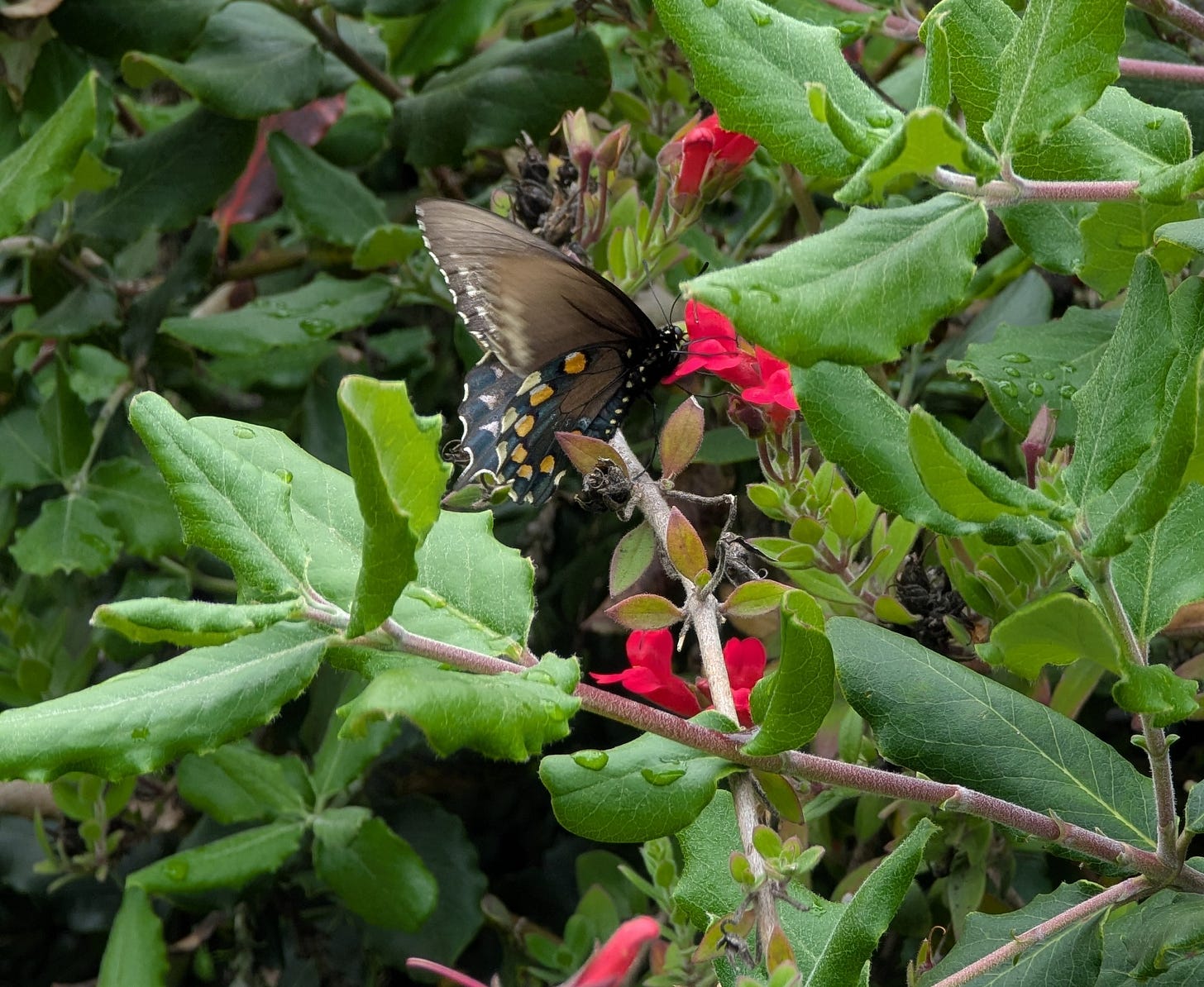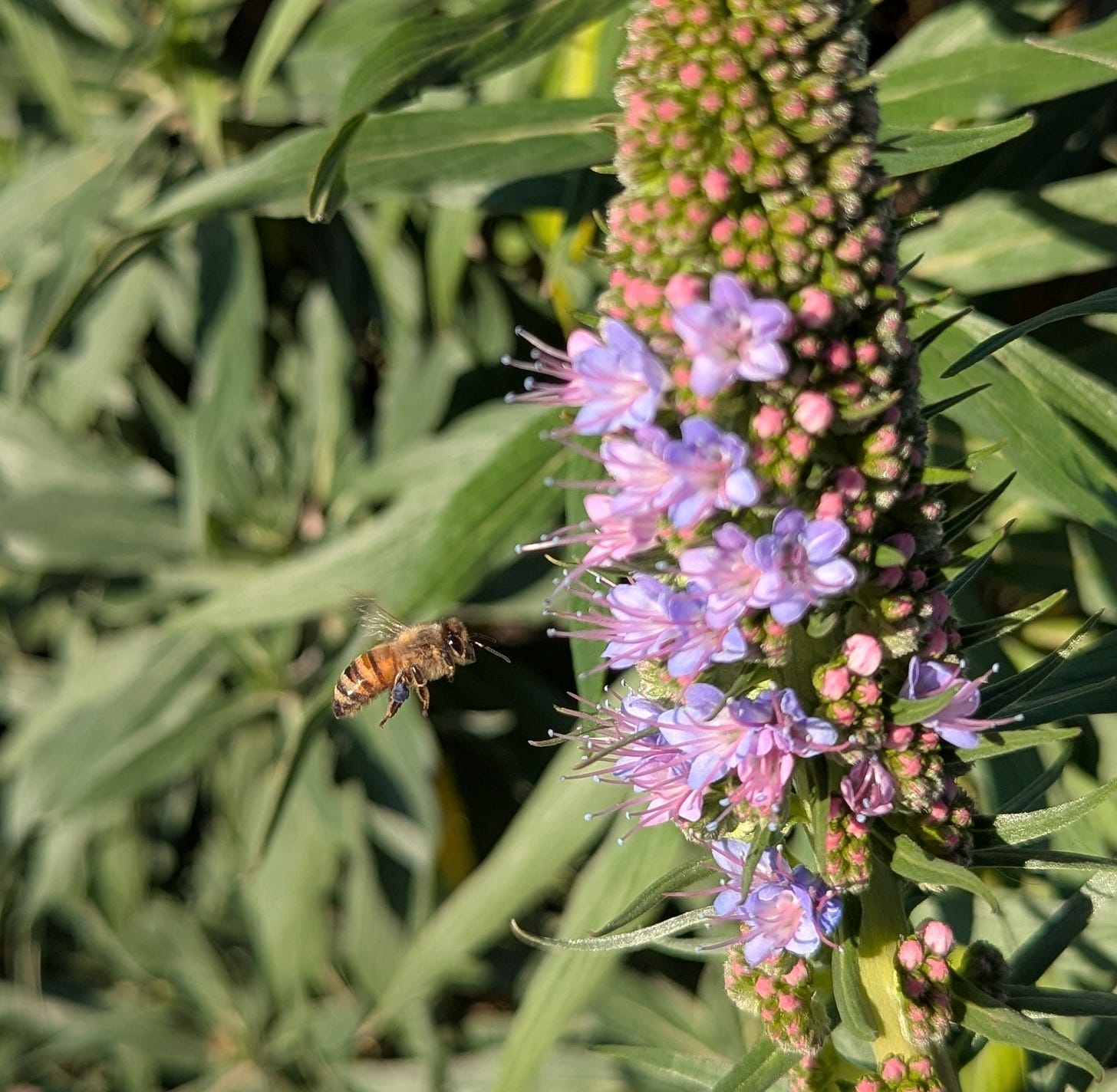Hopeful headlines: Canada provides refuge to very important stars; Giant tortoises help sprout endangered ebony seeds
Plus, more great renewables news, sea turtles rebound, rivers restored in the UK, Chinese porpoises increase, Mexican grey wolves on the rise, and so much more

Canada: Cold fjords provide refuge for endangered sunflower stars, saviors of kelp forests
Critically endangered sunflower stars — a keystone predator in kelp forests — have been spotted in mass numbers hiding out in the cold fjords of Canada, say researchers with the Hakai Institute.
This is incredibly good news for North America’s West Coast kelp forests!!
Sunflower stars all but vanished from 2,000 miles of coastal waters during a bout of warm water called “The Blob” that began in 2013. As a result, their prey, purple sea urchins, exploded in numbers and devoured kelp from Northern California to Washington, creating vast urchin barrens.
Kelp forests are nurseries for ocean life, providing refuge for young fish to mature.
[M]members of the team began diving in several of the fjords and found many more of the sunflower stars there than anywhere else. They suspect it is likely due to the cold water. Arctic outflow, they note, results in cold winds blowing across the region, which cools the water and also adds more oxygen.
Sunflower stars are the wolves of the kelp forest. They are the fastest-moving animals in their ocean habitat at 200 feet per hour. Their presence alone has been observed keeping urchins away, perhaps due to pheromones. They can grow to three feet (1 meter) wide and live for decades.
Sea otters, California sheephead and spiny lobster also eat purple urchin, but these only inhabit warmer, southern waters. Sea otters formerly roamed all of the West Coast’s nearshore waters, and scientists are looking at reintroductions in Northern California and Oregon, precisely because of their urchin-eating, kelp-forest-stewarding ways.
Since The Blob, only one or two sunflower sea stars have been spotted in Northern California. The Sunflower Star Laboratory is working to grow sea stars for release to the wild.
Perhaps, one day, Canada could loan us a few stars from their cold fjords. Truly, one more reason to remain friendly with our dear neighbor.


Indian Ocean: Giant tortoises help sprout seeds of endangered ebony trees
Aldabra giant tortoises were feared extinct in 1900. Now, on this 60-square-mile island in the Indian Ocean, 150,000 giant tortoises are engineering the ecosystem they’ve inhabited for millions of years, eating the grass to a turf, dispersing seeds and helping trees sprout, reports Smithsonian Magazine.

Scientists have been studying the tortoises for clues on how island ecosystems functioned before global tortoise extinctions. They discovered that the tortoises’ digestive tract helps sprout the seeds of endangered trees:
Some seeds benefit from spending time in a tortoise’s gut. Several rewilding projects on the islands of Rodrigues and Mauritius, about 700 miles south of here, are using tortoises from Aldabra to do the work formerly provided by three extinct species. They’re helping restore the ancient forests lost to logging. They not only carry seeds of numerous species but also help them sprout, including endangered trees like the ebony.
“For many, like the ebony, 2 or 3 percent germinate without going through a tortoise. And 80 percent germinate after,” says Hansen.
Cool!
In comparison, 15,000 giant tortoises, cousins of the Aldabra, remain on the Galapagos Islands across the world, thanks to decades of conservation efforts and invasive rat and goat eradication.
Aldabra Atoll lacks a continuous fresh water source. This limited human habitation and may have saved the Aldabra tortoise from extinction. Now, scientists are reintroducing the tortoises to surrounding islands where they’ve long been extinct, including Madagascar.
Global: Most Sea Turtles Rebounding Due to Conservation Efforts
Conservation efforts to protect sea turtles across the globe are working, according to a recent analysis by NOAA scientists. Some populations have seen increases by orders of magnitude. For example, between 2008 and 2020 the annual number of loggerhead nests increased from around 500 to 35,000 in Cape Verde in the North Atlantic Ocean.
Targeted efforts like improving fishing gear, turning off near-shore lights that confuse baby turtles, and a universal drop in hunting have shown results for most of the seven sea turtle species.
“Sea turtles are a shining light of marine conservation with recoveries of many nesting populations,” said Graeme Hays, Distinguished Professor and Chair in Marine Science at Deakin University in Australia.
Leatherback turtles, the largest of all the species, are still declining due to habitat loss, dangerous fishing gear and lack of recovery from previous egg harvesting. Climate change will also pose many challenges to sea turtles, as rising temperatures affect eggs and result in 99 percent of hatchlings being born female. However, the huge rebound in their numbers has scientists optimistic they will be more resilient to climate change.
“The bottom line is: When you stop hunting and otherwise harming species and they regain their ecological foothold, they can again become a thriving part of the marine ecosystem,” [NOAA Fisheries researcher Jeffrey] Seminoff said. “There will always be surprises, but now many sea turtles have greater resilience going forward.”
England: From agricultural ditches to wildlife havens that reduce flooding in small towns
I’ve got two examples from the UK where agricultural ditches were restored to functioning rivers to improve water quality, trap sediment, welcome back wildlife and reduce flooding downstream.
First, the folks at Dorset Wildlife Trust restored 170 hectares (420 acres) of former intensive farmland. Frogs, birds, snakes and deer immediately returned to the site, which is called Wild Woodbury, home to one of the largest rewilding projects in the country. Over 1,900 species have since been recorded, including mice, shrew and field voles. These have attracted such birds as the buzzard, kestrel, red kite, sparrow-hawk, hobby, peregrine falcon, goshawk, osprey, white-tailed eagle, hen harrier and short-eared owl. Grazing animals were also deemed ecologically beneficial. Don’t miss the incredibly cute pig moment at minute 19!
The second video here is an older one about the restoration of the River Mease in the Midlands. Same concept: Dam the channels, slow the water, allow the land to be the filter, and take out the sediment, phosphorous and other agricultural runoff. Watch wildlife return.
Global: Renewables now make up 41 percent of electricity generation. Wow.
Energy think tank Ember has analyzed data from 215 countries to show that renewables — including wind, solar, geothermal, hydropower and nuclear — now make up 41 percent of global electricity generation. Solar power generation has doubled in three years, adding more capacity than any other source. Read the report (available in several languages).
"Solar power has become the engine of the global energy transition,” said Ember Managing Director Phil MacDonald. “Paired with battery storage, solar is set to be an unstoppable force. … The world is watching how technologies like [artificial intelligence] and [electric vehicles] will drive electricity demand. It’s clear that booming solar and wind are comfortably set to deliver, and those expecting fossil fuel generation to keep rising will be disappointed. Cleantech, not fossil fuels, is now the driving force of economic development. The era of fossil growth is coming to an end, even in a world of fast-rising demand.”
Woot-woot!

Many more headlines caught my eye: Hold on tight!
Yangtze porpoise growth reflects river conservation success in China
Peru: From Mongabay: Indigenous aguaje tree climbers bring down profits in Amazon — sustainably
Africa: First Niger Delta red colobus monkey videos reflect community conservation success
Wales: Risen from the Ashes: 25 years of conservation success at Newport Wetlands National Nature Reserve (a site that once housed storage lagoons for pulverised fuel ash from a neighbouring power station)
USA: 🧐The New York Times’ climate desk has discovered solutions-based reporting: “50 States, 50 Fixes”:
[The first installment in the series] highlights climate and environmental solutions in five states, including a 100-acre nature preserve in Hawaii, a car-free neighborhood in Arizona and geothermal energy that is helping to power Idaho’s capital.
California: Beavers are multiplying after reintroductions, recharging groundwater and creating fire breaks: Native Calif. species known as 'nature’s Swiss Army knife' is growing
Georgia, USA: Seeking the threatened red-cockaded woodpecker at the Jones Center at Ichauway. Biologists drilled man-made cavities into longleaf pines and saw these rare woodpeckers return.
Pennsylvania: Conservation Success at Hawk Mountain Sanctuary
A global hotspot for raptor diversity, an estimated 18,000 raptors pass through Hawk Mountain Sanctuary every autumn, peaking at 3,000 a day in mid-September during the height of broad-wing hawk migration.
US Southwest, from The Associated Press: More endangered Mexican gray wolves are roaming the southwestern US, annual survey shows
The smallest subspecies of gray wolf in North America, Mexican wolves were listed as endangered in 1976, and a binational captive breeding program was started to guard against extinction. The reintroduction program has been the source of many legal battles over the years — with environmentalists seeking to get more captive wolves released into the wild and ranchers fighting to protect their way of life.
GO, PEOPLE PROTECTING NATURE! GO, NATURE HEALING PEOPLE! 😊

PS: I love it when I’m right about Substack writers
has a piece on opossums that is winning the internet. With more than 700 likes and counting, “Three Cheers for Opossums!...Anyone?” has more likes than anything I’ve ever read here (aside from the big authors like Heather and Paul). I’ve been recommending Alexandra’s publication, “Our Wild Neighbors,” since I arrived on Substack last July. She wrote about frogs in Massachusetts just as my mother-in-law, who lives in the state, was complaining that she no longer heard frogs at her neighborhood pond. Alexandra informs us that “Every landscaping and garden decision we make, big and small, has profound effects, for better or for worse, on [frogs’] ability to survive in cities and towns.” She then works through all the ins and outs of how to welcome back frogs. Clue: Native plants, not grass, provide food and habitat for bugs that frogs eat.
Meanwhile, I’ve also recommended
of “Rock & Hawk” for a while, and he’s experiencing nice growth after this awesome note stole the heart of Lady Algorithm.James is a birder and survivor of traumatic brain injury who somehow gracefully combines the two topics into a newsletter that is usually an onslaught of beauty.
Congrats, James and Alexandra!
About Earth Hope:
Earth Hope is a solutions-based journalism project that highlights environmental success stories from around the globe. I’m Amanda Royal, a former newspaper reporter and current eco-news junkie. Read more about this project and what inspired it.
Visit earthhope.substack.com for more stories. Visit my Services page if you’re a writer who’d like some help figuring out Substack.







I am going to read this to my family at our brunch today because we all need hopeful headlines. Yay!
Thank you for these hopeful headlines, Amanda! I love the comparison that sunflower stars are the wolves of the kelp forest. I hope the sea turtles serve as an example that responsible changes to our lifestyles--e.g. fishing gear--can pay off if we broaden our sphere of concern to include wildlife. If we broaden it even further, to the entire planet, we can see that changes like more fully embracing renewables and leaving fossil fuels in the past will allow us to preserve a healthier planet without slowing economic development. 41% is an encouraging statistic.
Thank you also for the kind mention. That's seriously high praise, and I'm grateful you read my writing here.